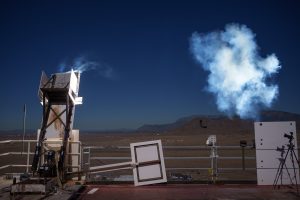
ALBUQUERQUE, N.M. — For decades, Sandia National Laboratories’ National Solar Thermal Test Facility has harnessed the power of the sun to expose aerospace materials to intense heat, replicating the harsh conditions of faster-than-sound flight and atmospheric reentry to ensure the materials’ ability to protect the rest of the vehicle. The most recent of these tests is in support of two exciting NASA missions.
The ambitious Mars Sample Return campaign, which is under a complete program review, is a NASA and European Space Agency mission that seeks to deliver Martian rocks to eager Earth-bound scientists. These samples could provide clues as to whether the Red Planet ever hosted life and help prepare for human exploration of Mars. If selected, the Sample Retrieval Lander segment of this mission would land the heaviest payload ever on Mars, including a rocket designed to launch a container of carefully selected samples into Mars’ orbit. Recently, NASA engineers tested heat shield materials for the Mars Lander at Sandia.
Click to watch a video of smoke billowing off NASA’s heat shield material during a recent test at Sandia National Laboratories’ National Solar Thermal Test Facility. Video from another test with audio from the test control tower can be found here. (Video by Craig Fritz) Members of the media may download and use the videos for the purpose of news story illustration.
“This would be the first mission to return rocks from Mars to Earth; it’s got a bigger payload,” said Ken Armijo, a Sandia engineer and test director for the NASA tests. “The heavier the payload and the bigger the entry vehicle, the hotter the vehicle gets during atmospheric entry, and the better the heat shield needs to be.”
What makes Sandia’s solar testing facility special is its ability to test samples of material up to 3 feet wide with different gases blowing over the samples to mimic the atmosphere of different worlds, Armijo said. This is done using sunlight focused by hundreds of mirror-like heliostats — rather than using energy guzzling arc jets or lasers, which are two other methods for testing materials for reentry. This could save between 15 to 60,000 kW per test, the equivalent of running 5 to 20,000 clothes dryers for the length of the test.
Sandia’s singular facilities
Sandia’s solar testing facility includes a 200-foot-tall power tower with a field of 212 mirrored heliostats.
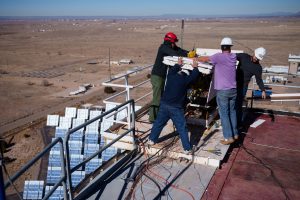
“We have high flux and high flux distribution on the Solar Tower,” Armijo said. “We can basically fit whole pieces of planes up there if we wanted to and blast them with concentrated sun beams. The high flux you experience during reentry and hypersonic flight is only part of what we can simulate.”
Flux represents the amount of light or energy hitting a certain area, often compared to the amount of sunlight that would hit a beach towel on a sunny day. Acting like a massive magnifying glass, Sandia’s solar test facility can focus sunlight up to 3,500 times this amount of light.
Arc jet testing costs up to $100,000 per day, while laser testing is similar at approximately $150,000 per day, while testing on the Solar Tower costs about $25,000 per day, Armijo explained. Another benefit is the ability to focus more heliostats upon the test material, changing the intensity of sunlight to mimic the stages of reentry or even the conditions of reentry on different celestial bodies, he added.
“Typically, NASA missions test their heat shield materials at several different facilities with different capabilities before certifying the material for flight,” said Brandon Smith, the lead engineer for heat shield materials for the Sample Retrieval Lander at NASA Jet Propulsion Laboratory. “Sandia’s ability to test at this size nicely complements our other test facilities.”
Materials testing for Mars and beyond
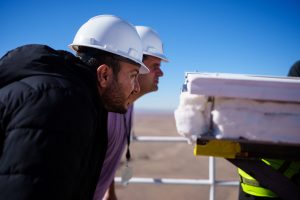
During NASA’s tests in the fall and winter of 2023, engineers tested 2-foot-wide samples of a material developed at NASA’s Ames Research Center. The heat shields for both the Mars Sample Retrieval Lander and a Titan-bound mission, Dragonfly, are designed to be made from this material, called Phenolic Impregnated Carbon Ablator. This material has been successfully used as heat shields for NASA’s missions Stardust, Mars Science Laboratory, Mars 2020 and OSIRIS-REx.
The tests were led by Keith Peterson, a materials scientist at NASA Ames Research Center. He said that other methods of testing materials for reentry are limited to smaller samples, only 8 inches in diameter. Since the solar test facility can test larger samples of material, NASA could test material samples that were slightly bent to simulate the physical strain a spacecraft would feel entering the atmosphere, and study mechanisms that show up only at larger length scales, Peterson added.
Dragonfly is a helicopter-like robot bound for Saturn’s largest moon, Titan, in development at the Johns Hopkins Applied Physics Laboratory. The rotorcraft is designed to fly multiple sorties once it reaches Titan, searching for chemical processes common to both Titan and very early Earth, prior to the formation of life. Titan could hold clues to how life may have arisen on our planet. However, with an atmosphere four times as dense as Earth, Titan poses its own challenges especially when it comes to designing a heat shield for the spacecraft to fly through the methane-rich atmosphere and deliver the rotorcraft.
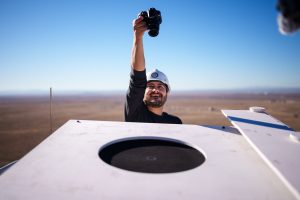
To mimic the thermal processes of atmospheric entry in the oxygen-less atmospheres of Mars and Titan, the researchers blow nitrogen gas across the heat shield sample. Recently, Sandia added a gas line from the base of the power tower to the top, Armijo said. A gas line is somewhat like a garden hose, providing high-pressure gas where materials testing occurs.
Sandia mechanical technologist Daniel Ray was responsible for installing the gas line and for fixing problems on the tests as they arise. He is the main welder and fabricator for the solar testing facility.
“My role on every project is to make it work,” Ray said. “During their first test, NASA had an issue with the protective carbon felt catching fire. The following morning, I made some ceramic shields to better channel the nitrogen and protect the test system, and it worked.”
Scorching solar slingshot
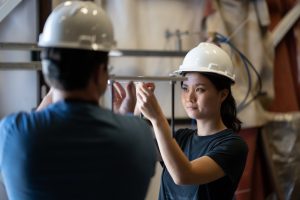
In 2022, researchers from the Applied Physics Laboratory tested a heat exchanger prototype designed to propel a rocket around the sun. They subjected the prototype to high solar flux on the Solar Tower.
The purpose of these new types of aerospace heat exchanger heat shields is to protect and propel future Voyager-type spacecraft as they slingshot around the sun to zip out into interstellar space, Armijo said. By flying closer to the sun, spacecraft could reach speeds three or four times those of Voyager 1, said Jessica Harsono, an APL mechanical engineer and leader of this project.
The APL researchers were able to test their heat exchanger prototype under the light of 2,000 suns for 10 minutes. During the test, the prototype reached over 3,100 degrees Fahrenheit and remained intact and operational, demonstrating the ability of the heat exchanger to survive its intended use, Harsono said. The researchers also tested several possible coatings for heat shield materials.
This was not the first time APL researchers tested aerospace subsystems at Sandia’s solar test facility, Armijo said. In fact, the first test for APL started in May 1979, when the solar test facility — designed and commissioned for energy research — was less than a year old.
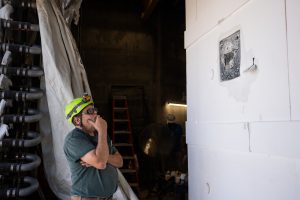
APL researchers came back in 2000 to test radar protection domes called radomes. Previously, NASA researchers have tested space shuttle tiles, sensors and communication systems to see if they would work during reentry. The facility has also been involved in testing nose cones for space shuttles and Air Force planes, and aerospace materials’ resilience to rapid temperature changes.
“This has blossomed into a lot of neat projects because, fundamentally, we have figured out a way to adjust our ability to focus heliostats on and off and adjust the spread of focused beams so we can tailor the flux profile over time to mimic real-world flight conditions,” Armijo said. “Because we can dial-in the profiles, we have more confidence that it’s going to survive and function well during a mission. Having confidence that it will make it to Mars, land and pick up the rocks safely is important.”





